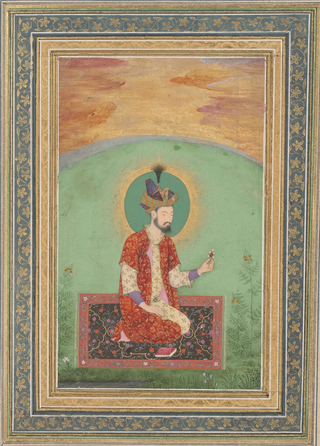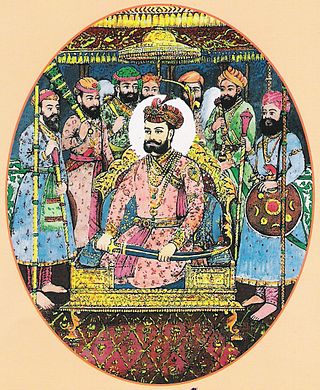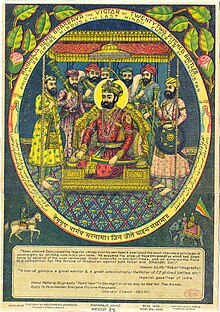
Nasir al-Din Muhammad, commonly known by his regnal name Humayun, was the second Mughal emperor, who ruled over territory in what is now Eastern Afghanistan, Bangladesh, Northern India, and Pakistan from 1530 to 1540 and again from 1555 to his death 1556. At the time of his passing, the Mughal Empire spanned almost one million square kilometres.

The Second Battle of Panipat was fought on 5 November 1556, between Akbar and the king of Delhi, Hemu. Hemu had conquered Delhi and Agra a few weeks earlier by defeating Mughal forces under Tardi Beg Khan in the battle of Delhi and crowned himself Raja Vikramaditya at Purana Quila in Delhi.

Sher Shah Suri, often called the "Just King", was the founder of the Sur Empire in India. He was the regent and later sole ruler of Bihar from 1529—1540 until he defeated the Mughal Empire in 1540, founding the Sur Empire, and establishing his rule in Delhi, crowning himself as Emperor. After his accidental death in 1545 CE, his son Islam Shah became his successor. The influence of his innovations and reforms extended far beyond his brief reign. In his reign, he remained undefeated in battle, being renowned as one of the most skillful Afghan generals ever produced.

Mandu or Mandavgad is an ancient city in the present-day Mandav area of the Dhar district. It is located in the Malwa and Nimar region of western Madhya Pradesh, India, at 35 km from Dhar city. In the 11th century, Mandu was the sub division of the Tarangagadh or Taranga kingdom. This fortress town on a rocky outcrop about 100 km (62 mi) from Indore is celebrated for its architecture.

Panipat is a historic city, located in Haryana, India. It is 95 km north of Delhi and 169 km south of Chandigarh on NH-1. The three major battles fought in 1526, 1556 and 1761 took place near the city. The city is famous in India as the "City of Weavers" and "Textile City". It is also known as the "cast-off capital" due to being "the global centre for recycling textiles". Panipat is also home to a variety of manufacturing industries including wool and cotton milling, saltpetre refining, and the manufacture of glass, electrical appliances, and other products. Panipat is included in the list of Critically Polluted Industrial Areas in India. The Comprehensive Environment Pollution Index (CEPI) of the city is 71.91 as against 88.50 of Ankaleshwar (Gujarat). The fatal field of Panipat is the site of three battles that changed the course of India's history, resulting in the creation and confirmation of the Mughal Empire. The third battle led to the decisive defeat of the Maratha Confederacy in North India, which became a dominating power in Delhi by then and paved the way for the British colonial rule of India.

The Agra Fort is a historical fort in the city of Agra, and also known as Agra's Red Fort. Mughal emperor Humayun was crowned at this fort. It was later renovated by the Mughal emperor Akbar from 1565 and the present-day structure was completed in 1573. It served as the main residence of the rulers of the Mughal dynasty until 1638, when the capital was shifted from Agra to Delhi. It was also known as the "Lal-Qila" or "Qila-i-Akbari". Before being captured by the British, the last Indian rulers to have occupied it were the Marathas. In 1983, the Agra fort was inscribed as a UNESCO World Heritage Site because of its importance during the Mughal Dynasty. It is about 2.5 kilometers (1.6 mi) northwest of its more famous sister monument, the Taj Mahal. The fort can be more accurately described as a walled city. It was later renovated by Shah Jahan.

Hemu was an Indian emperor who previously served as a general and Wazir of Adil Shah Suri of Sur Empire during a period in Indian history when Mughals and Afghans were vying for power across North India. He fought Afghan rebels across North India from Punjab to Bengal and Mughal forces of Humayun and Akbar in Agra and Delhi, winning 22 battles for Adil Shah Suri.

Muhammad Bairam Khan, commonly known as Bairam Khan or Bayram Khan was an important military commander, and later commander-in-chief of the Mughal army, a powerful statesman and regent at the court of the Mughal Emperors, Humayun and Akbar. He was also the guardian, chief mentor, adviser, teacher and the most trusted ally of Akbar. Akbar honoured him as Khan-i-Khanan, which means "King of Kings". Bairam was originally called Bairam "Beg", but later became honoured as Khan. Bairam Khan was an aggressive general who was determined to restore Mughal authority in India.

Khanzada Mirza Khan Abdul Rahim, popularly known as simply Rahim and titled Khan-i-Khanan, was a poet who lived in India during the rule of Mughal emperor Akbar, who was Rahim's mentor. He was one of the nine important ministers (dewan) in Akbar's court, known as the Navaratnas. Rahim was known for his Hindustani dohe (couplets) and his books on astrology.

Tardi Beg, born Mirza Muhammad Beg Zulfiqar Khan, was a military commander in the 16th century in Mughal Empire. He served under the Mughal Emperors Humayun and Akbar. Beg was part of Humayun's forces when they retreated from India after the siege by Sher Shah. He remained with his leader throughout his exile in Persia.

Delhi has been an important political centre of India as the capital of several empires. The recorded history of Delhi begins with the 8th century Tomar Rajputs kingdom. It is considered to be a city built, destroyed and rebuilt several times, as outsiders who successfully invaded the Indian subcontinent would ransack the existing capital city in Delhi, and those who came to conquer and stay would be so impressed by the city's strategic location as to make it their capital and rebuild it in their own way.

Sikandar Shah Suri was the sixth ruler of the Sur Empire, a late medieval Pashtun dynasty of northern India. He became the sultan of Delhi after overthrowing Ibrahim Shah Suri.

Adil Shah Suri was the seventh and final ruler of the Sur Empire. He was the brother in law of Sikandar Shah Suri, who ruled over a region east of Delhi after Sikandar Shah Suri was defeated by Humayun in 1555. He and Sikandar Shah Suri were contenders for the Delhi throne against the Mughal emperor Akbar.

Abu'l-Fath Jalal-ud-din Muhammad Akbar, popularly known as Akbar the Great, and also as Akbar I, was the third Mughal emperor, who reigned from 1556 to 1605. Akbar succeeded his father, Humayun, under a regent, Bairam Khan, who helped the young emperor expand and consolidate Mughal domains in the Indian subcontinent.
Shaikh Gadai Kamboh was the son, disciple and successor of famous scholar, philosopher and poet-laureate Shaikh Jamali Kamboh of Delhi and brother of the 'Master of Expression' —Shaikh Abd-al-Hai Hayati. His real name was Abdur Rehman but he became famous as Gadai. He was well-renowned for his sanctity and learning and was in high favour with emperor Humayun and Bairam Khan. He is also said to have remained a Musahib of the Afghan emperor Salim Shah Suri. During Akbar’s reign, he occupied the high office of “Sadr-i-sadur” of Hindustan.
Events in the year 1556 in India.

The Chunar Fort is located in Mirzapur district of Uttar Pradesh, in India. Along with Chunar town, near Mirzapur city, situated below the fort, the two are historic places with common history and legends. It is located 34 kilometres (21 mi) North west of Mirzapur. The southeastern part of the fort is on the rocky bank of the Ganges River. The fort's history spans from 56 BC and then between Afghan decedent Sher Shah Suri's (1532) rule, the Mughal Empire rule up to 1772, and Marathas in 1782 to 1804. Lastly, the British Raj occupied the fort to 1947 when India gained independence. Chunar railway station is on the Pt. Deen Dayal Upadhyaya–Kanpur section of Howrah–Delhi main line.

Salima Sultan Begum was the third wife and chief consort of the Mughal emperor Akbar, and the granddaughter of Babur.

Hemu's Smadhi Sthal, is a memorial to the Hindu king Hemu at Shodapur village on Jind road near Panipat city in Panipat district of Haryana state in India. It stands at the location where he was executed.
The Battle of Sirhind was fought between the Mughal Empire and the Suri Empire in 1555.



















